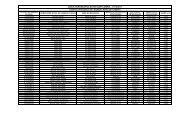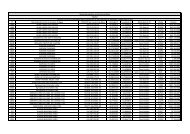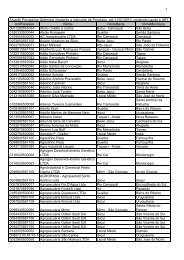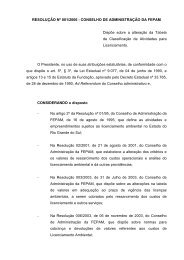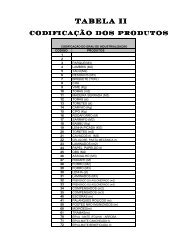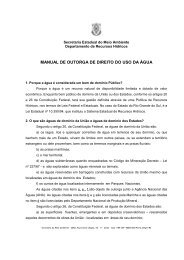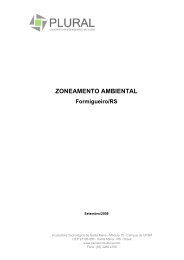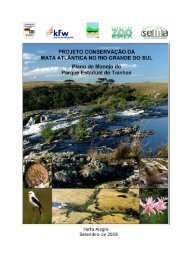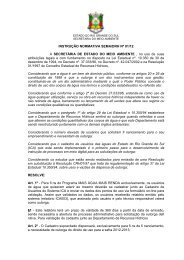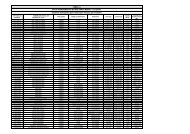Gestão Ambiental e Negociação de Conflitos em Unidades ... - Sema
Gestão Ambiental e Negociação de Conflitos em Unidades ... - Sema
Gestão Ambiental e Negociação de Conflitos em Unidades ... - Sema
Create successful ePaper yourself
Turn your PDF publications into a flip-book with our unique Google optimized e-Paper software.
AbstractRoad building is consi<strong>de</strong>red to be responsible for landscape <strong>de</strong>gradation,while being hit by vehicles is consi<strong>de</strong>red to be the main anthropiccause of wildlife direct mortality. In this chapter, we present the results ofa one-year monitoring of road killings on Rota do Sol highway, and discusssome relevant approaches to mitigate such impact. Throughout th<strong>em</strong>onitoring period, the number of wild animals being run over by vehiclesvaried throughout the year, with one high peak of amphibian road killingand the major road killing of all the groups of vertebrates occurring duringspring and summer. In<strong>de</strong>pen<strong>de</strong>ntly of the chosen scale, the evaluation ofits spatial distribution has indicated that road killings of wild animals are aggregated.The main hotspots where the most number of animals are foundrun over are concentrated in the lowlands, with some of the hotspots superimposedwith the so called area of Mata Paludosa Biological Reserve,where there are three fauna un<strong>de</strong>rpasses. These results point at the factthat even though there are un<strong>de</strong>rpasses, the animals are still crossing theroads; thus leading to the necessity of impl<strong>em</strong>enting radar speed vehiclecontrollers. In any road there are many situations to which mitigation hasto be adjusted. Knowledge gaps indicated in this chapter <strong>de</strong>monstrate theneed of long-term monitoring programs that allow evaluation of measuresalready impl<strong>em</strong>ented and the planning of new mitigation strategies.Key words – Road killing hotspots, spatial distribution, mitigation measures,road ecology1. IntroduçãoNeste capítulo apresentamos os resultados <strong>de</strong> um estudo <strong>de</strong>senvolvidona Rota do Sol entre 2009 e 2010, no qual monitoramos os animais atropeladosna rodovia, visando à i<strong>de</strong>ntificação dos locais com maior número<strong>de</strong> atropelamentos. A partir dos resultados discutimos algumas abordagensrelevantes para a minimização <strong>de</strong>sse conflito com a fauna silvestre. Primeiramente,apresentar<strong>em</strong>os uma breve revisão dos impactos <strong>de</strong> rodovias sobrea fauna silvestre no mundo e das estratégias utilizadas para sua mitigação.1.1 Impactos <strong>de</strong> rodovias sobre a vida silvestreRodovias são responsáveis por conectar as populações humanas <strong>de</strong>diferentes locais, dando acesso a uma gran<strong>de</strong> varieda<strong>de</strong> <strong>de</strong> recursos, e sãofundamentais no atual contexto socioeconômico da maioria da populaçãohumana (PERZ et al., 2008). Entretanto, a construção <strong>de</strong> estradas é também76



